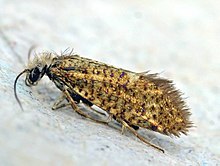
Back قطيميات Arabic قطيميات ARZ Eriocrànids Catalan Eriocraniidae CEB Trugmotten German Eriocraniidae Spanish پشمکسران Persian Päistärkoit Finnish Eriocraniidae French Félszipókás pillefélék Hungarian
| Eriocraniidae | |
|---|---|

| |
| Eriocrania semipurpurella | |
| Scientific classification | |
| Domain: | Eukaryota |
| Kingdom: | Animalia |
| Phylum: | Arthropoda |
| Class: | Insecta |
| Order: | Lepidoptera |
| Suborder: | Glossata |
| Infraorder: | Dacnonypha Hinton, 1946 sensu Minet, 2002[1] |
| Superfamily: | Eriocranioidea |
| Family: | Eriocraniidae Rebel, 1901 |
| Genera | |
|
Dyseriocrania | |
| Diversity | |
| 25 described species | |
Eriocraniidae is a family of moths restricted to the Holarctic region, with six extant genera.[2][3] These small, metallic moths are usually day-flying, emerging fairly early in the northern temperate spring. They have a proboscis with which they drink water or sap. The larvae are leaf miners on Fagales, principally the trees birch (Betula) and oak (Quercus), but a few on Salicales and Rosales.[4]
- ^ Joël Minet (2002). "Un nom d'infra-ordre pour les Acanthopteroctetidae (Lepidoptera)" [Proposal of an infraordinal name for the Acanthopteroctetidae (Lepidoptera)]. Bulletin de la Société entomologique de France. 107 (3): 222. doi:10.3406/bsef.2002.16845. S2CID 89221735.
- ^ Donald R. Davis (1978). "A revision of the North American moths of the superfamily Eriocranioidea with the proposal of a new family, Acanthopteroctetidae (Lepidoptera)" (PDF). Smithsonian Contributions to Zoology. 251 (251): 1–131. doi:10.5479/si.00810282.251. Archived (PDF) from the original on 19 July 2019. Retrieved 8 May 2011.
- ^ Hitomi Mizukawa, Toshiya Hirowatari & Satoshi Hashimoto (2004). "Biosystematic study of Issikiocrania japonicella Moriuti (Lepidoptera: Eriocraniidae), with description of immature stages". Entomological Science. 7 (4): 389–397. doi:10.1111/j.1479-8298.2004.00088.x. S2CID 85351035.
- ^ Kristensen, Niels P. (31 December 1998). "5. The Homoneurous Glossata". In Kükenthal, Willy (ed.). Band 4: Arthropoda, 2 Hälfte: Insecta, Lepidoptera, Moths and Butterflies, Teilband/Part 35, Volume 1: Evolution, Systematics, and Biogeography. Handbuch der Zoologie. De Gruyter. pp. 51–64. doi:10.1515/9783110804744.51. ISBN 978-3-11-015704-8. Archived from the original on 3 April 2024. Retrieved 17 May 2024.